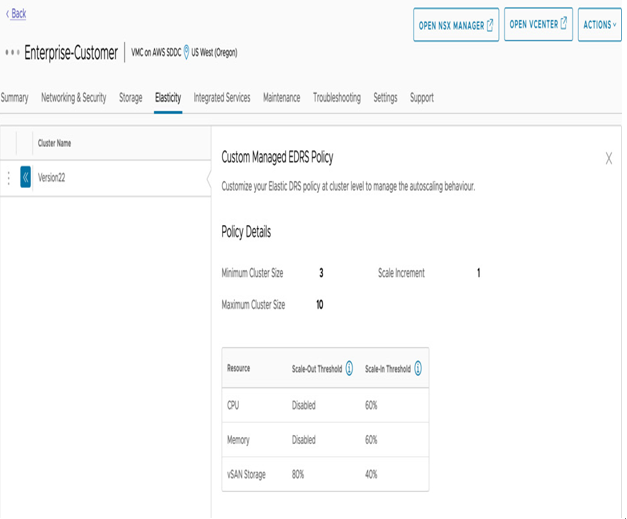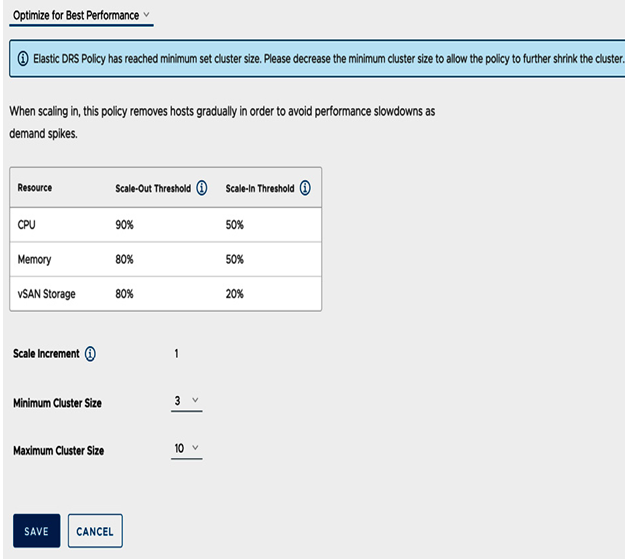The Elastic DRS is a unique differentiator capability of VMware Cloud on AWS. The Elastic DRS service combines the functionality of vSphere DRS with the elastic capacity of public clouds. By constantly monitoring host and storage utilization in the vSphere cluster, Elastic DRS prevents capacity and performance shortages and automatically accommodates the increase in capacity. It is also capable of scaling in a cluster to control costs.
The Elastic DRS algorithm runs every five minutes and can account for random utilization spikes. Additionally, there is a 30-minute delay for a scale-up and a 3-hour wait for subsequent scale-in events.
Elastic DRS settings are applied per cluster. Control over Elastic DRS configuration has now moved to the Elasticity tab, as outlined previously.

Figure 5.12 – Managing custom Elastic DRS policies
Each cluster has a default Elastic DRS baseline policy assigned upon creation. The default baseline policy only monitors for storage and initiates the expansion of the cluster only once the storage utilization reaches 80%.
Note
Disabling Elastic DRS at the cluster level is not supported. Furthermore, it is not possible to adjust the upper threshold for storage utilization beyond 80%.
VMware Cloud on AWS provides flexible configurations for Elastic DRS to accommodate the specific design requirements of your workload while meeting performance, capacity, and cost considerations. You have the option to configure Elastic DRS using predefined policies, although the defined thresholds within these policies cannot be modified. Alternatively, you can create custom Elastic DRS policies to tailor the configuration according to your specific needs.
Please be aware that when using custom or predefined Elastic DRS policies, a scale-out action will only be triggered if any of the defined thresholds are reached. In contrast, the scale-in action will only be triggered if all the defined metrics drop below their respective thresholds. It’s important to note that all metrics are monitored at the host level.
Elastic DRS baseline policy
By default, this policy is enabled and cannot be disabled. When the vSAN utilization reaches 80%, Elastic DRS will automatically trigger a process to add a host. This proactive measure guarantees that there is sufficient available slack storage in the vSAN to accommodate the growth of the applications’ storage requirements.
Information
VMware mandates a minimum of 20% of unused space, known as slack space, to be maintained within the vSAN datastore, in order to ensure smooth operation of the SDDC. It is crucial to have sufficient slack space in the vSAN datastore for its proper utilization. In the event that the free storage space reaches or falls below 25%, there is a risk that the customer may lose the ability to use the SDDC, rendering the environment inoperable. To prevent any harm to the SDDC, if the unused space in an SDDC vSAN datastore drops to 30% or below, VMware will automatically add hosts to the SDDC.
Optimize for Best Performance policy
To ensure a consistent application performance, it is recommended to enable this policy. Once the cluster utilization of CPU, memory, or storage reaches the defined threshold, Elastic DRS will initiate a scale-out action. This proactive measure guarantees a consistent performance of the underlying compute infrastructure. You can check the policy configuration in the following figure:

Figure 5.13 – Optimize for Best Performance Elastic DRS policy settings